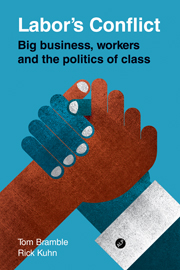Book contents
- Frontmatter
- Contents
- Preface
- Introduction
- 1 Labor's love's lost?
- 2 In the beginning: Labor's first quarter century
- 3 Between the Wars
- 4 Hot war, cold war, split
- 5 Labor after 70 years
- 6 The Whitlam era
- 7 Economic rationalism under Hawke and Keating
- 8 Labor in the wilderness
- 9 The Rudd–Gillard government
- 10 The Labor Party today: what's left
- Notes
- Index
2 - In the beginning: Labor's first quarter century
Published online by Cambridge University Press: 10 January 2011
- Frontmatter
- Contents
- Preface
- Introduction
- 1 Labor's love's lost?
- 2 In the beginning: Labor's first quarter century
- 3 Between the Wars
- 4 Hot war, cold war, split
- 5 Labor after 70 years
- 6 The Whitlam era
- 7 Economic rationalism under Hawke and Keating
- 8 Labor in the wilderness
- 9 The Rudd–Gillard government
- 10 The Labor Party today: what's left
- Notes
- Index
Summary
The ALP was born out of a period of prolonged economic boom followed by a devastating crash. The boom and subsequent bust and the social turmoil that went with it put a definite stamp on the character of the Party. In this chapter we describe the circumstances of the Party's formation, its initial electoral success, consolidation and early record in office, before turning to the tumultuous years of World War I when Labor experienced and survived its first convulsive split.
In the 30 years leading up to the Party's formation in 1891, the Australian colonies expanded at an unprecedented rate. Population increased by more than two and a half times while gross domestic product more than tripled. Medium and large businesses began to appear in the major cities and regional towns. These processes had a dramatic impact on the workforce and class divisions became more sharply defined. As the size of businesses grew, the scope for skilled workers and artisans to climb into the employer class declined and the proportion of self-employed people fell. In 1891 almost two-thirds of breadwinners in New South Wales were employees.
With the sharpening of class distinctions, trade unions began to grow rapidly. Not only skilled workers – including those in urban trades and shearers – but also the semiskilled and unskilled – such as miners, most railway workers, urban and rural labourers – organised in large numbers in the Australian colonies.
- Type
- Chapter
- Information
- Labor's ConflictBig Business, Workers and the Politics of Class, pp. 25 - 42Publisher: Cambridge University PressPrint publication year: 2010



